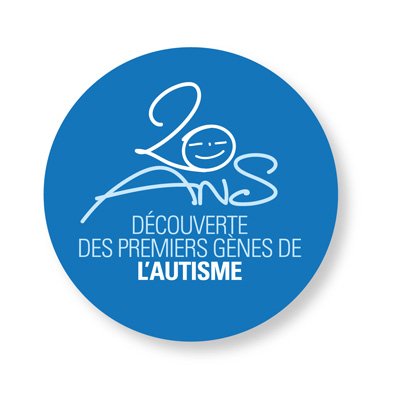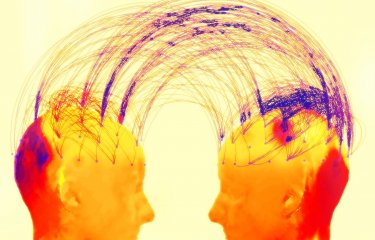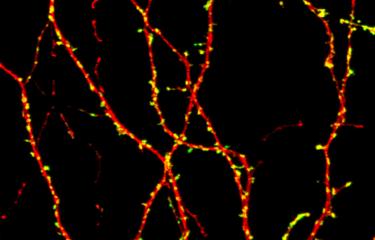As we mark World Autism Awareness Day on Sunday April 2, 2023, this year the Institut Pasteur is celebrating the 20th anniversary of the discovery of the first genes associated with autism. In 2003, this discovery offered a new perspective on the neurodevelopmental disorder; today, it highlights what still needs to be done to help those affected by autism. Scientists in international consortia are currently focusing their efforts on large-scale studies and participatory research to elucidate the complex mechanisms involved in autism, which combine both genetic and environmental factors, and to move towards a system of personalized support.

On March 31, 2003, when an international team[1] led by psychiatrists Professor Christopher Gillberg and Professor Marion Leboyer and the geneticist Professor Thomas Bourgeron first discovered genetic mutations involved in autism, it was the start of a new era for both scientists and families.
"Our results confirmed the contribution of genetics to autism, which we had strongly suspected since the 1970s when the twins study was published," explains Thomas Bourgeron, Head of the Institut Pasteur's Human Genetics and Cognitive Functions Unit and a Professor of Genetics at Université Paris Cité. The discovery also gave us a better understanding of the biological mechanisms involved."
The proteins encoded by these genes, known as neuroligins, were particularly enlightening. They are involved in the formation of synapses (contact points between neurons). The scientists' study showed that autism could be a consequence of the establishment of atypical brain connections. This theory was subsequently confirmed, since most of the genes identified – more than 200 to date and hundreds more suspected – appear to participate to a greater or lesser extent in pathways converging in synapse formation or function.
Over the past decade – Genetic architecture of autism
Just as there is great diversity among people with autism, recent analyses have revealed the complex genetic architecture of the condition. As Thomas Bourgeron summarizes, "We all share the same genes, but from one person to the next there are on average 3 million variations that set us apart. It is this combination that contributes to our interindividual differences. The probability of being autistic is often the result of a cocktail of thousands of genetic variations that have little effect on their own but whose impact is cumulative. In other cases, however, a single variation on a single gene is all it takes for a person to be autistic. These monogenic forms generally manifest severely, in some cases with intellectual disability." This is the case, for example, with mutations in the SHANK3 gene, again identified by the scientist's team at the Institut Pasteur in 2006. These mutations cause Phelan-McDermid syndrome, which is responsible for generalized developmental delay affecting verbal and non-verbal language and social communication in a broader sense. The huge challenge facing research today is identifying the multiple genetic variations involved, understanding their impact on brain development and pinpointing all the factors that contribute to the emergence of vulnerability for the individual. "This involves an enormous amount of multidisciplinary work to link genomics, brain function as visualized with brain imaging, and clinical practice," emphasizes Thomas Bourgeron. "And above all we need large volumes of properly structured data in shared databases. This is why we pool our efforts in international consortia and especially European consortia, which benefit from ad hoc funding. This research is starting to bear fruit, and in the coming years we will see new progress."
In 2023 and for the future – Ambitious international programs...
The aim of these major European projects is to identify a panel of biomarkers with the potential to reflect the full range of symptoms so as to diagnose cases of autism more precisely, and also to test new strategies for prevention and treatment. Thomas Bourgeron's team is involved in the genetic component of two large-scale European studies, CANDY(2) and AIMS-2-Trials(3). In connection with AIMS-2-Trials, the Institut Pasteur has developed and hosts Owey, one of the largest databases on autism in Europe.
"We are very proud of it," says Thomas Bourgeron enthusiastically. "These data are accessible to the entire scientific community. We are also coordinating the R2D2-MH (Risk and Resilience in Developmental Diversity and Mental Health) study, which has 26 partners from the EU and associated countries (Austria, Canada and Israel). Launched in October 2022, R2D2-MH is the first study to include stakeholders from the autism community to such a large extent as part of a participatory research process."
... And new partnerships between scientists, clinicians and stakeholders
Professor Richard Delorme, who heads the Child and Adolescent Psychiatry Department at Robert-Debré Hospital (AP-HP) and the Excellence Center for autism spectrum and neurodevelopmental disorders (InovAND) in Paris, comments: "Participatory research is a necessary revolution in autism. It enables us to ask questions in a different way and encourages us to seek innovation for each autistic individual, to apply our results to achieve vital improvements in developmental trajectories. This requires a dynamic approach and an ever greater determination to succeed. The idea is not to understand just for the sake of understanding, but to understand so that together we can improve the quality of life of each autistic individual."
This view is confirmed by Stéf Bonnot-Briey, who has autism and is a trainer and co-founder of PAARI (the Association of Autistic People for Responsible and Innovative Self-Determination): "People affected by autism have not just gone from being the object of research to the subject of research; they have become stakeholders in their own right. This paradigm shift remains a challenge, as participatory research requires a process of reciprocal acculturation: we need to get to grips with the scientific microcosm and the codes that govern it, while the scientists need to better understand and take into account our issues. This process requires a certain amount of time to get to know each other and establish a relationship of trust, but we also need to capitalize together on this time for the benefit of individuals both now and in the future."
"The aim of the R2D2-MH study is to improve the well-being of people with a neurodevelopmental disorder (including autism)," concludes Professor Thomas Bourgeron. "As well as risk factors, we will be studying what are known as resilience factors, which lead to a better lifelong trajectory. We are expecting a lot from this research and hope that it will enable us to offer effective support. For while genetics is a key component in autism, the environment also plays a role, and that is the major hope for the coming years: being able to intervene at a much earlier stage, in a personalized way, with families and children who need this support to better overcome their difficulties and develop their skills."
Autism spectrum disorder at a glance
- Between 0.9 and 1.2% of births, in other words approximately 7,500 births each year in France. Some studies mention 1 case for every 58 births (1.7%).
- Approximately 700,000 people affected in France: 100,000 people under the age of 20 and nearly 600,000 people over 20.
- Onset age: before 3 years old (symptoms start at around 15 months on average; sometimes from birth, sometimes at around 24 months).
- Three times more boys are diagnosed than girls. The sex ratio varies depending on intellectual function: it is close to 1 (1 boy for every girl) for autism associated with intellectual disability.
- Included as a neurodevelopmental disorder in DSM-5 (the fifth edition of the Diagnostic and Statistical Manual of Mental Disorders).
- Two main symptom areas:
- Social communication difficulties affecting social interactions and verbal and non-verbal communication;
- Restricted interests and repetitive behaviors, sensory sensitivities (in 85 to 90% of people with autism, including hypersensitivity to sound, light, touch, etc.).
- Highly variable severity and disability.
- Often accompanied by other conditions: intellectual disability (in 35% of cases), attention deficit disorder with or without hyperactivity (AD(H)D, 50 to 80% of cases), epilepsy (10 to 15% of cases), sleep disorders (60 to 70% of cases), gastrointestinal disorders (35 to 40% of cases), etc.
- The life expectancy of people with autism is on average 20 years lower than the general population (primarily because of a lack of social or physical stimulation (sport) and support for basic care).
|
LISPHEM*, a pilot clinical study for Phelan-McDermid syndrome "Research is leading to progress! Twenty years ago, there were still doubts about the genetic aspect of autism. Now we are conducting therapeutic trials to see whether certain drugs can help people with severe forms. Our aim is also to improve diagnosis so that we can offer better support, tailored to the needs and skills of each individual." Dr. Anna Maruani, child psychiatrist in the Child and Adolescent Psychiatry Department at Robert-Debré Hospital (AP-HP) and coordinator of the Reference Center for Rare Diseases – Rare Intellectual Disabilities. Based on a study led by Professor Thomas Bourgeron and Professor Richard Delorme, Head of the Excellence Center for autism spectrum and neurodevelopmental disorders (InovAND) in Paris, the LISPHEM pilot study led by Dr. Anna Maruani aims to test lithium (vs. placebo) as a treatment for improving social communication deficits in 22 people aged 7 to 17 who have Phelan-McDermid syndrome (with a variation in the SHANK3 gene) with autism. * Effect of Lithium in Patients with Autism Spectrum Disorder and Phelan-McDermid Syndrome – SHANK3 Haploinsufficiency |
Ressources
- Ministry of Solidarity, Autonomy and Persons with Disabilities: https://handicap.gouv.fr/autisme-et-troubles-du-neuro-developpement
- Des gènes, des synapses, des autismes - Un voyage vers la diversité des personnes autistes. Thomas Bourgeron. Published by Odile Jacob, January 2023. EAN13 9782415003906
- Autisme, la grande enquête. Sophie Le Callennec, Florent Chapel. Published by Les Arènes, March 2016. ISBN 9782352044949
- Accompagnement des familles, Clépsy: www.clepsy.fr
Sources
- Communiqué de presse diffusé le 31 mars 2003 "Deux gènes associés à l'autisme identifiés"
- Mutations of the X-linked genes encodage neuroligins NLGN3 and NLGN4 are associated with autism" - Nature Genetics - Mai 2003
Stéphane Jamain1, Hélène Quach1, Catalina Betancur2, Maria Rastam3, Catherine Colineaux2,4, I. Carina Gillberg3, Henrik Söderström3, Bruno Giros2, Marion Leboyer2,5, Christopher Gillberg3,6, Thomas Bourgeron1, & the PARIS study7
1 Laboratoire d'Immunogénétique Humaine, Equipe INSERM 21, Université Paris 7, Institut Pasteur, Paris
2 Unité INSERM 513, Faculté de Médecine, Université Paris XII, Créteil
3 Department of Child and Adolescent Psychiatry, Göteborg University, Suède
4 Département de Psychiatry de l'Enfant et de l'Adolescent, HôpitalRobert Debré, Paris
5 Département de Psychiatrie, Hôpital Albert Chenevier et HenriMondor, Créteil
6 Saint George'sHospitalMedical School, Londres, UK
7 Paris AutismResearch International Sibpair Study
Cet article est en ligne surle site de Nature Genetics : http://www.nature.com/ng/
PMID: 12669065
PMCID: PMC1925054
DOI: 10.1038/ng1136
[1] En collaboration avec Thomas Bourgeron (Unité Génétique humaine et fonctions cognitives, CNRS UMR 3571, Institut Pasteur, Université Paris Cité), Marion Leboyer (Unité Inserm 513/Université Paris XII/CHU de Créteil) et Christopher Gillberg (hôpital de l’université de Göteborg en Suède).
https://www.pasteur.fr/sites/default/files/rubrique_espace_presse/documents_de_presse/communiques_de_presse/2003_03_31_cp_autisme_2genes.pdf
[2] Comorbid Analysis of Neurodevelopmental Disorders and Epilepsy: https://www.candy-project.eu/
[3] Autism Innovative Medicine Studies-2-Trials: https://www.aims-2-trials.eu





